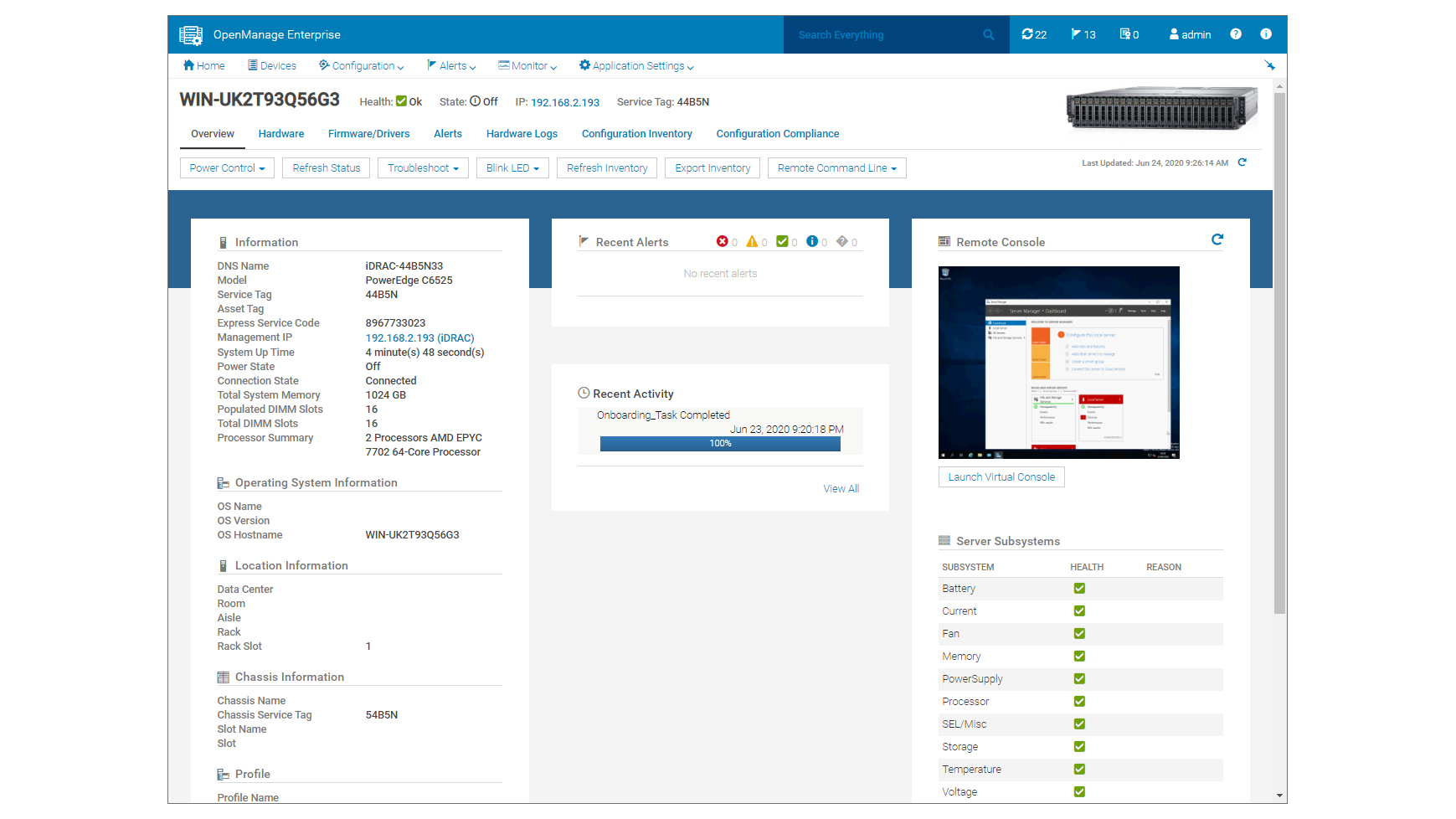Dell EMC PowerEdge C6525 review: A beast of truly EPYC proportions
Dell’s multi-node server takes core density to the next level


-
+
Staggering core density
-
+
Supports all EPYC 7002 CPUs
-
+
Good node expansion potential
-
+
Plenty of storage options
-
+
Enterprise-class management tools
-
-
Quick Sync 2 module not supported

AMD's EPYC 7002 CPUs offer a server core density that Intel can only dream of and Dell EMC's PowerEdge C6525 takes full advantage of this. Inside its 2U rack enclosure, there's room for up to four dual-socket server nodes which support the entire EPYC 7002 stack - including the new 7Fx2 high-frequency models - allowing it to deliver an unbelievable maximum density of 512 physical and 1,024 logical cores.
With this much power on tap, enterprises can easily consolidate multiple servers into one system and conceivably build a complete data centre out of a single rack. Naturally, high-performance computing (HPC) and hyperscale workloads are target applications but cost-conscious businesses can also deploy the nodes in single-CPU configurations and still achieve high core densities plus additional savings on lower data centre cooling demands.
Storage choices look good too, since the chassis is available with a wide range of LFF and SFF SAS3/SATA drives plus NVMe SSDs. You can dispense with the backplane completely, as the nodes have a number of integral storage choices as well.
Dell EMC PowerEdge C6525 review: Chassis
The C6400 chassis is the same model as used by Dell's PowerEdge C6420 Xeon Scalable nodes, where they slot in at the rear and function as completely independent units. The chassis supports two hot-plug PSUs and along with the dual 2,400W Platinum models in our review system, Dell also offers 2,000W and 1,600W versions.
Power is distributed to the nodes via a mid-plane management board while a separate drive expander backplane provisions allotted storage to each node. Both power and storage are neatly amalgamated into one plug for each node, sliding easily into the rear of the chassis and employing a small edge connector to receive all services.

The chassis supports up to 12 LFF or 24 SFF hot-swap bays where each node gets an equal share of drives. The optional NVMe backplane presents each node with two NVMe SSDs and four SFF SAS3/SATA hard disks or SSDs.
All air cooling is handled by four cold-swap, dual-rotor fans which, unsurprisingly, run at very high speeds. If noise is an issue, and also if you want to use the 280W TDP EPYC CPUs, Dell offers liquid-cooled sleds made by CoolIT Systems that comprise CPU cold plates, stainless steel manifolds, non-drip quick disconnects and various heat exchange modules.
Dell EMC PowerEdge C6525 review: Node features
The C6525 nodes pack a remarkable specification into a relatively small space. The two EPYC CPU sockets are arranged in line down the centre of the motherboard with each flanked by eight DIMM slots.
Our review system was equipped with two C6525 nodes each sporting dual 64-core 2.0GHz EPYC 7702 CPUs. These were teamed up with sixteen 64GB 3,200MHz DDR4 RDIMM modules for the maximum 1TB capacity – use 128GB LRDIMMs and you can go up to 2TB per node.
The nodes have a single Gigabit port which doubles up as a link to the iDRAC9 management controller and as a standard NIC. An OCP 3.0 mezzanine card edge slot adds more network options as along with the dual 10GbE SFP+ module in our nodes, Dell offers plenty of Gigabit, 10GbE, 25GbE and 100GbE alternatives. The slot also accepts open-standard OCP 3.0 network cards from other partners as well as Dell's own offerings.
The nodes have embedded S150 SATA RAID controllers so if you want SAS3 storage, you'll need to add a Dell PERC adapter in each node. That's no problem as they have two half-height PCI-E 4 risers ready and waiting.
We've also included Dell's BOSS (boot optimized storage solution) PCI-E card which snuggles into a dedicated slot at the rear of the node. It provides mirrored M.2 SSD storage for running an OS and is required if you want the diskless chassis.

Dell EMC PowerEdge C6525 review: Node management
The nodes are endowed with the full iDRAC9 embedded controller so server management doesn't get any better. Its slick web console provides everything you need to know about node operations, hardware and health although it doesn't provide the System page CPU performance tab, which is still unable to support AMD's architecture.
The iDRAC9 comes preloaded with a choice of performance BIOS profiles which can be selected from the web console. Our nodes also had an Enterprise X5 license applied to enable remote console and virtual media services, while streaming telemetry for predictive analytics comes courtesy of a Datacenter X5 license.
We run Dell's OpenManage Enterprise (OME) 3.4 software in the lab as a Hyper-V VM and added both our C6525 nodes as managed servers using their iDRAC9 addresses. The OME web console provides plenty of details on system status along with options to control server power, load a remote control console and automate routine maintenance tasks.
The chassis has two node power buttons on each rack ear - which means there's no room for Dell's Quick Sync 2 Bluetooth module. Even so, we were still able to manually add the iDRAC9 address of each node to the OpenManage Mobile (OMM) iOS app on our iPad and use it to monitor their status, view all server information, alerts plus health readouts and launch a remote virtual console.
Dell EMC PowerEdge C6525 review: Verdict
Dell's close collaboration with AMD is producing some remarkable server solutions that competing blue chips can't even come close to matching. When we reviewed Dell's PowerEdge R7525 2U rack server, we were impressed with its EPYC core density and the C6525 takes this into the stratosphere.
Cramming 512 EPYC cores into 2U of rack space is no mean feat and Dell achieves this with a smartly designed and highly flexible solution. Along with the surprisingly expandable nodes, it offers plenty of storage choices, while server management tools are beyond reproach - making it perfect for serious server consolidation projects, HPC applications and hyperscale workloads.
Dell EMC PowerEdge C6525 specifications
| Chassis | Dell C6400 2U rack enclosure |
| Node slots | Up to four C6525 nodes |
| Power | 2 x 2,400W hot-plug PSUs |
| Storage | No backplane included |
| Nodes | 2 x C6525 nodes included each with the following specification |
| CPU | 2 x 64-core 2GHz AMD EPYC 7702 |
| Memory | 1TB 3,200MHz RDIMM DDR4 ECC (max 2TB with LRDIMM) |
| Storage | Dell BOSS with 2 x 480GB M.2 SSDs (RAID 1) |
| RAID | Embedded S150 SATA |
| Network | 2 x 10GbE SFP+ OCP 3.0 mezzanine card |
| Other | Mellanox ConnextX-6 Single Port HDR100 QSFP56 Infiniband PCI-E |
| Expansion | 2 x PCI-E 4.0 X16 risers |
| Management | Dell iDRAC9 Enterprise X5 |
| Warranty | 3Yr ProSupport On-Site NBD |
Get the ITPro daily newsletter
Sign up today and you will receive a free copy of our Future Focus 2025 report - the leading guidance on AI, cybersecurity and other IT challenges as per 700+ senior executives
Dave is an IT consultant and freelance journalist specialising in hands-on reviews of computer networking products covering all market sectors from small businesses to enterprises. Founder of Binary Testing Ltd – the UK’s premier independent network testing laboratory - Dave has over 45 years of experience in the IT industry.
Dave has produced many thousands of in-depth business networking product reviews from his lab which have been reproduced globally. Writing for ITPro and its sister title, PC Pro, he covers all areas of business IT infrastructure, including servers, storage, network security, data protection, cloud, infrastructure and services.
-
 ‘Phishing kits are a force multiplier': Cheap cyber crime kits can be bought on the dark web for less than $25 – and experts warn it’s lowering the barrier of entry for amateur hackers
‘Phishing kits are a force multiplier': Cheap cyber crime kits can be bought on the dark web for less than $25 – and experts warn it’s lowering the barrier of entry for amateur hackersNews Research from NordVPN shows phishing kits are now widely available on the dark web and via messaging apps like Telegram, and are often selling for less than $25.
By Emma Woollacott Published
-
 Redis unveils new tools for developers working on AI applications
Redis unveils new tools for developers working on AI applicationsNews Redis has announced new tools aimed at making it easier for AI developers to build applications and optimize large language model (LLM) outputs.
By Ross Kelly Published
-
 Google layoffs continue with "hundreds" cut from Chrome, Android, and Pixel teams
Google layoffs continue with "hundreds" cut from Chrome, Android, and Pixel teamsNews The tech giant's efficiency drive enters a third year with devices teams the latest target
By Bobby Hellard Published